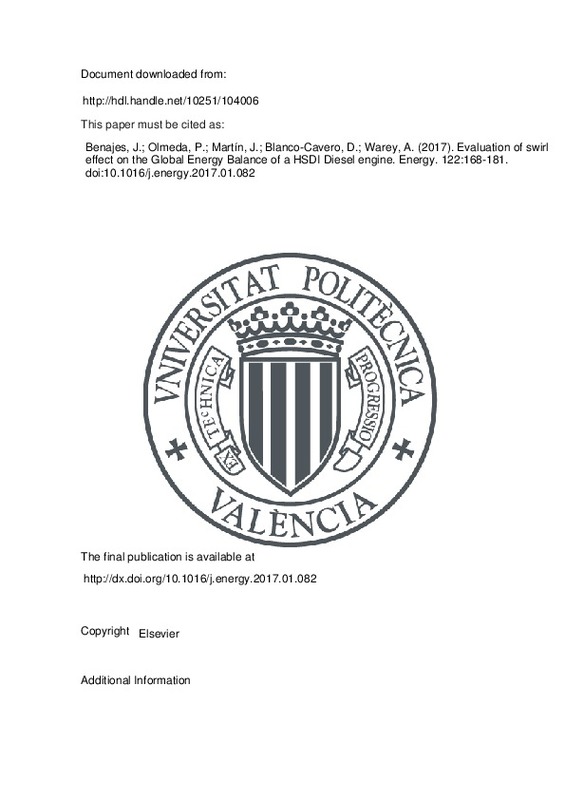JavaScript is disabled for your browser. Some features of this site may not work without it.
Buscar en RiuNet
Listar
Mi cuenta
Estadísticas
Ayuda RiuNet
Admin. UPV
Evaluation of swirl effect on the Global Energy Balance of a HSDI Diesel engine
Mostrar el registro sencillo del ítem
Ficheros en el ítem
| dc.contributor.author | Benajes, Jesús
|
es_ES |
| dc.contributor.author | Olmeda, P.
|
es_ES |
| dc.contributor.author | Martín, J.
|
es_ES |
| dc.contributor.author | Blanco-Cavero, Diego
|
es_ES |
| dc.contributor.author | Warey, Alok
|
es_ES |
| dc.date.accessioned | 2018-06-14T04:29:26Z | |
| dc.date.available | 2018-06-14T04:29:26Z | |
| dc.date.issued | 2017 | es_ES |
| dc.identifier.issn | 0360-5442 | es_ES |
| dc.identifier.uri | http://hdl.handle.net/10251/104006 | |
| dc.description.abstract | [EN] In the last years, a growing interest about increasing engine efficiency has led to the development of new engine technologies. Since air motion in the chamber is a key issue in internal combustion engines to improve the air-fuel mixing process and achieve faster burning rates, modern Diesel engines are designed to generate gas vorticity (swirl) that lead to enhanced turbulence in the combustion chamber. However, the use of swirl has a direct effect on fuel consumption due to the changes in the in-cylinder processes, affecting indicated efficiency, and also on the air management. An analysis, based on the engine Global Energy Balance (GEB), is presented to thoroughly assess the behavior of a high speed direct injection Diesel engine under variable swirl levels at different operating points. The tests have been performed keeping constant both the conditions at intake valve closing and combustion phasing, thus minimizing the variability due to in-cylinder conditions and the combustion process. The analysis includes a combination of theoretical (0D models) and experimental tools (heat rejection and wall temperature measurement) used to ensure control of in-cylinder conditions and to provide detailed explanation of the different phenomena affecting engine efficiency when swirl ratio is modified. Based on these tools, impact of swirl on the engine GEB is analyzed in detail paying special attention to engine efficiency and heat transfer in the chamber. Results show that increasing swirl has two main effects regarding the gross indicated efficiency (eta(i)): on one hand chamber heat rejection increases and therefore eta(i) diminishes about -0.5% at low load and 0.4% at high load; on the other hand combustion development is affected and thus a eta(i) improvement higher to 1.5% is achieved at low load and speed. The combination of these effects leads to a gross indicated efficiency increase higher to 1% at an optimum swirl ratio that diminishes when engine speed increases. In addition, pumping losses effect dominates brake efficiency behavior, which always diminishes (from 0.9% to 1.4%) when swirl increases. (C) 2017 Elsevier Ltd. All rights reserved. | es_ES |
| dc.description.sponsorship | The support of GM Global R&D and the Spanish Ministry of Economy and Competitiveness (TRA2013-41348-R) is greatly acknowledged. | |
| dc.language | Inglés | es_ES |
| dc.publisher | Elsevier | es_ES |
| dc.relation.ispartof | Energy | es_ES |
| dc.rights | Reconocimiento - No comercial - Sin obra derivada (by-nc-nd) | es_ES |
| dc.subject | Engine | es_ES |
| dc.subject | Heat transfer | es_ES |
| dc.subject | Swirl | es_ES |
| dc.subject | Global Energy Balance | es_ES |
| dc.subject | Split of losses | es_ES |
| dc.subject.classification | MAQUINAS Y MOTORES TERMICOS | es_ES |
| dc.title | Evaluation of swirl effect on the Global Energy Balance of a HSDI Diesel engine | es_ES |
| dc.type | Artículo | es_ES |
| dc.identifier.doi | 10.1016/j.energy.2017.01.082 | es_ES |
| dc.relation.projectID | info:eu-repo/grantAgreement/MINECO//TRA2013-41348-R/ES/EVALUACION DEL EFECTO DE LA TRANSMISION DE CALOR EN LA CAMARA SOBRE LA EFICIENCIA DE MOTORES DIESEL DE PEQUEÑA CILINDRADA/ | es_ES |
| dc.rights.accessRights | Abierto | es_ES |
| dc.date.embargoEndDate | 2019-03-01 | es_ES |
| dc.contributor.affiliation | Universitat Politècnica de València. Departamento de Máquinas y Motores Térmicos - Departament de Màquines i Motors Tèrmics | es_ES |
| dc.description.bibliographicCitation | Benajes, J.; Olmeda, P.; Martín, J.; Blanco-Cavero, D.; Warey, A. (2017). Evaluation of swirl effect on the Global Energy Balance of a HSDI Diesel engine. Energy. 122:168-181. https://doi.org/10.1016/j.energy.2017.01.082 | es_ES |
| dc.description.accrualMethod | S | es_ES |
| dc.relation.publisherversion | http://dx.doi.org/10.1016/j.energy.2017.01.082 | es_ES |
| dc.description.upvformatpinicio | 168 | es_ES |
| dc.description.upvformatpfin | 181 | es_ES |
| dc.type.version | info:eu-repo/semantics/publishedVersion | es_ES |
| dc.description.volume | 122 | es_ES |
| dc.relation.pasarela | S\329055 | es_ES |
| dc.contributor.funder | Ministerio de Economía, Industria y Competitividad | es_ES |







![[Cerrado]](/themes/UPV/images/candado.png)

